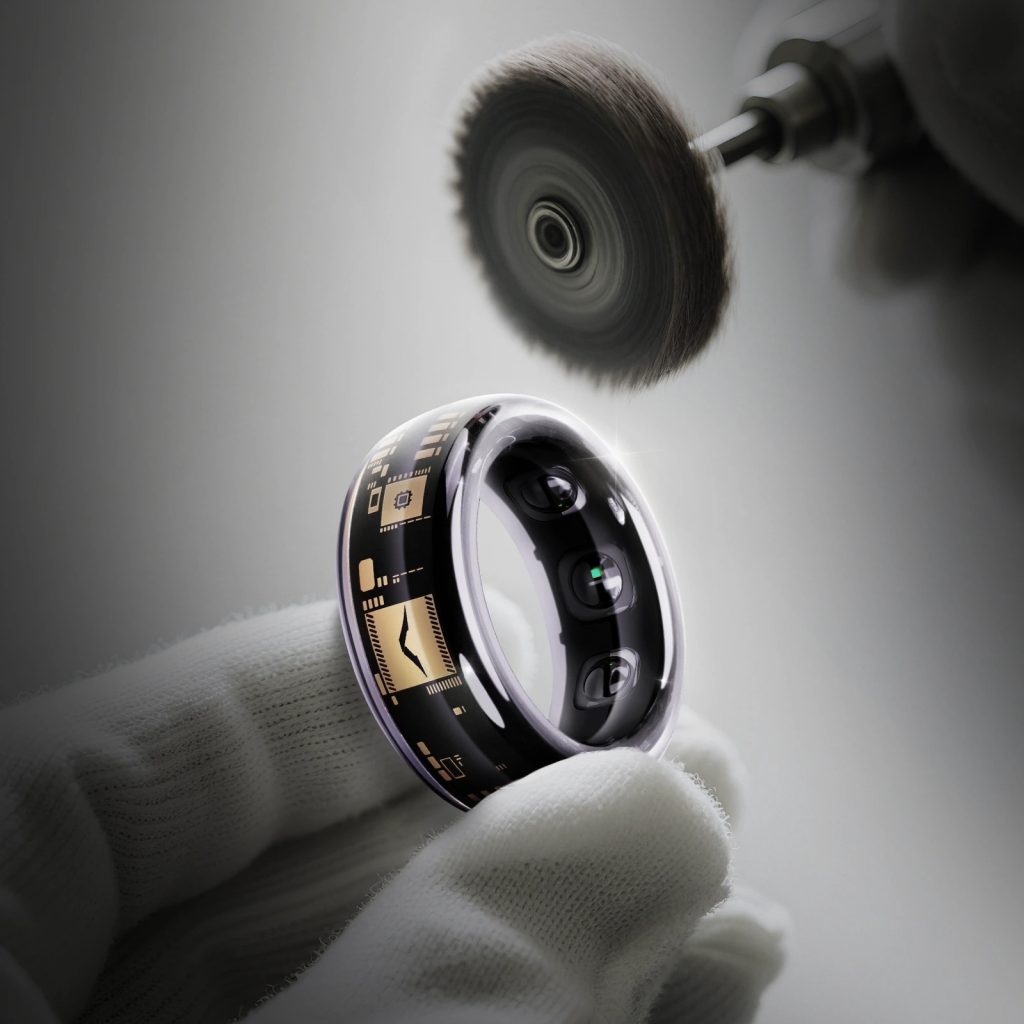Introduction: The Convergence of Crystal Wisdom and Modern Biometric Science
The Vertu Smart Crystal Ring represents far more than a technological device—it embodies the ancient understanding of crystals as energy conductors combined with cutting-edge biometric science. Throughout history, crystals have been recognized as energy amplifiers, each with unique vibrational frequencies that harmonize with human wellness. The purple amethyst crystal at the heart of this ring isn't merely aesthetic; it symbolizes the ring's core function: to enhance your inner energy through scientifically-backed monitoring and optimization.
Your body generates energy through every movement, every breath, every heartbeat. This energy—when understood and optimized—transforms your physical health, mental clarity, emotional resilience, and overall vitality. The Vertu Smart Crystal Ring quantifies this energy through METs (Metabolic Equivalent of Task), translates it into actionable insights, and creates a harmonious ecosystem where crystal wisdom meets biometric precision. This synergy enables you to achieve optimal body composition management while enhancing your complete wellness trajectory.
Understanding MET: The Scientific Foundation of Your Daily Energy
MET (Metabolic Equivalent of Task) is the fundamental unit measuring how much energy your body consumes during any activity compared to your resting state. One MET represents the oxygen your body uses when sitting quietly—your metabolic baseline. This simple concept unlocks profound insights into your wellness because every activity carries a specific MET value that directly correlates to energy expenditure, caloric burn, and health benefits.
MET Values Across Daily Activities
The beauty of understanding MET lies in recognizing that every single movement contributes to your overall energy expenditure. Consider these common activities and their corresponding MET values:
- Sleeping: 0.9 MET (rest state)
- Sitting at desk: 1.5 MET (office work)
- Walking slowly (2 mph): 2.8 MET (leisurely pace)
- Casual walking (3.5 mph): 3.5 MET (moderate pace)
- Brisk walking (4 mph): 5.0 MET (purposeful movement)
- Light jogging (5 mph): 8.3 MET (cardiovascular intensity)
- Running (6 mph): 9.8 MET (aerobic challenge)
- Intense interval training: 12-15 MET (maximum effort)
- Household chores (vacuuming): 3.5-4.5 MET (practical activity)
- Climbing stairs: 8.8-11.0 MET (powerful activation)
This classification reveals a crucial wellness principle: your everyday movements—not just structured workouts—contribute significantly to your total energy expenditure and body composition management. The subtle difference between sitting (1.5 MET) and standing while working (2.0 MET) might seem insignificant, but over 8 hours, that 0.5 MET difference equals approximately 240 additional calories burned weekly.
The Vertu Smart Crystal Ring automatically tracks these MET values throughout your entire day, ensuring no energy expenditure escapes measurement. This comprehensive tracking transforms your understanding of how daily choices compound into extraordinary health results.
Calculating Calories: From MET to Precise Energy Expenditure
Calculating calories burned during exercise follows a scientific formula that combines MET values with your individual physiology:
Calories Burned = MET Value × Body Weight (kg) × Duration (hours)
Practical Calorie Calculation Examples
Let's examine how this formula translates into real-world energy expenditure:
Example 1: Moderate Walking
- Activity: Casual walking at 3.5 mph (3.5 MET)
- Duration: 30 minutes (0.5 hours)
- Body weight: 70 kg
Calculation: 3.5 MET × 70 kg × 0.5 hours = 122.5 calories burned
By simply dedicating 30 minutes to moderate walking, you've expended meaningful energy while maintaining conversational pace. Over a week, this single habit accumulates 857.5 calories—equivalent to one pound of body weight reduction or significant body composition improvement.
Example 2: Intense Interval Training
- Activity: High-intensity interval training (12 MET average)
- Duration: 20 minutes (0.33 hours)
- Body weight: 70 kg
Calculation: 12 MET × 70 kg × 0.33 hours = 264 calories burned
The same 70kg person burns more than double the calories in one-third the time through intensity. This illustrates the MET principle: higher intensity activities accelerate energy expenditure and body composition transformation.
Example 3: Daily Office Work with Movement Integration
- Morning: Desk work (1.5 MET) for 3 hours = 315 calories
- Mid-morning: Stair climbing (8.8 MET) for 10 minutes = 103 calories
- Afternoon: Desk work (1.5 MET) for 4 hours = 420 calories
- Evening: Walking (3.5 MET) for 45 minutes = 183 calories
Daily Total: 1,021 calories burned through integrated activity
Why Individual Variation Matters
The standard calorie calculation provides accurate estimates based on average physiological responses. However, several individual factors create meaningful variations in actual calorie expenditure:
- Age: Metabolic rate decreases approximately 2-3% per decade after age 30
- Body composition: Muscle tissue burns more calories at rest than fat tissue (5-10 additional calories per pound daily)
- Fitness level: Trained individuals often burn fewer calories during identical activities due to biomechanical efficiency
- Genetics: Individual metabolic rates vary by up to 25% due to genetic factors
- Hormonal status: Thyroid function, estrogen, and other hormones significantly influence calorie expenditure
The Vertu Smart Crystal Ring moves beyond generic calculations by personalizing your energy metrics through continuous biometric monitoring. Your ring doesn't just apply average MET values—it calibrates them based on your heart rate response, heart rate variability, oxygen utilization efficiency, and recovery patterns, creating precision calorie tracking that surpasses standard fitness devices.
The VERTU Energy Algorithm: Revolutionary Energy Quantification
While standard MET calculations provide solid baseline data, the Vertu Smart Crystal Ring introduces the VERTU Energy (V.E.) Algorithm—a proprietary system that transforms raw biometric data into a unified, comprehensive energy metric that accounts for your unique physiology.
Understanding the VERTU Energy Formula
V.E. (VERTU Energy) = MET Index × Duration × V-Factor
This elegant formula operates on a principle that transcends basic mathematics: your energy expenditure isn't merely the product of activity intensity and duration—it's modulated by your individual physiological response pattern.
The V-Factor: Your Personalized Energy Multiplier
The V-Factor represents your unique physiological signature, calibrated through continuous monitoring of:
Heart Rate Intensity: Your cardiovascular response to activity reveals whether your body is efficiently converting energy or working inefficiently. The ring monitors your heart rate during activity and compares it to your baseline, creating a V-Factor that reflects your cardiovascular fitness level and current physiological state.
Heart Rate Variability (HRV): The variation between consecutive heartbeats indicates your nervous system's balance and stress resilience. Higher HRV generally correlates with better fitness and faster recovery. The ring uses HRV patterns to fine-tune your V-Factor—on high-HRV days (optimal recovery), your V-Factor increases; on low-HRV days (accumulated fatigue), it adjusts downward to reflect reduced efficiency.
Oxygen Saturation (SpO2): Your blood oxygen level during activity indicates how efficiently your lungs and cardiovascular system deliver oxygen to working muscles. The ring monitors SpO2 trends and integrates this into your V-Factor, creating higher multipliers when your oxygen utilization is efficient and lower multipliers when temporary hypoxia suggests reduced efficiency.
Metabolic Efficiency Index: By comparing your caloric expenditure to your heart rate response, the ring calculates whether your body is operating efficiently (low heart rate, high calorie burn) or inefficiently (elevated heart rate, lower calorie burn). Efficient days receive higher V-Factors; inefficient days (indicating fatigue, illness, or overtraining) receive lower multipliers.
Circadian Alignment: Your body's energy expenditure varies based on circadian rhythm alignment. Morning activity often generates higher V-Factors due to optimal cortisol levels and circadian synchronization, while late-night activity might receive lower multipliers reflecting circadian misalignment.
Real-Time V.E. Calculation Example
Consider two identical 30-minute walks at 3.5 MET by the same 70kg person:
Monday Walk (Optimal Recovery Day)
- Base calculation: 3.5 MET × 70 kg × 0.5 hours = 122.5 calories
- Heart rate response: Controlled, averaging 110 bpm
- HRV: Excellent (85 ms average variability)
- SpO2: 98% throughout activity
- V-Factor: 1.12 (optimized state)
V.E. Score: 122.5 × 1.12 = 137.2 V.E.
Friday Walk (Accumulated Fatigue)
- Base calculation: 3.5 MET × 70 kg × 0.5 hours = 122.5 calories
- Heart rate response: Elevated, averaging 128 bpm
- HRV: Reduced (52 ms average variability)
- SpO2: 96% with occasional dips to 94%
- V-Factor: 0.88 (compromised state)
V.E. Score: 122.5 × 0.88 = 107.8 V.E.
The identical walk generates a 29.4 V.E. difference, reflecting the reality that your body's true energy expenditure varies based on physiological state. The ring captures this nuance, providing insight that static MET calculations miss entirely.
Your Daily VERTU Energy Score
Throughout your day, the Vertu Smart Crystal Ring continuously calculates V.E. points for every activity, rest period, and sleep phase. Your accumulated daily score appears as a unified metric:
“Today Your Energy Index: 850 V.E. (VERTU Energy)”
This crystalline number represents your complete daily wellness performance. Unlike fragmented metrics (steps, calories, heart rate), the V.E. score integrates all dimensions of your physiology into one meaningful number that reflects:
- Total energy expenditure (how much you moved)
- Movement quality (how efficiently you moved)
- Recovery status (how well your body recovered)
- Stress resilience (how well you managed pressure)
- Metabolic health (how effectively your body processed energy)
Over time, your average V.E. score becomes your wellness signature—a number that reveals whether your lifestyle is optimizing or compromising your health trajectory.
24/7 Health Monitoring: The Foundation of Inner Energy Enhancement
Enhancing your inner energy requires comprehensive understanding of how your body functions across all states—activity and rest, waking and sleeping, stress and recovery. The Vertu Smart Crystal Ring delivers 24/7 health monitoring across seven critical dimensions of your wellness ecosystem.
Sleep Monitoring: The Cornerstone of Energy Restoration
Sleep quality represents the most critical factor determining your daily energy levels, mental clarity, and physical resilience. The Vertu Smart Crystal Ring analyzes your sleep architecture through sophisticated sensors that track:
Sleep Stage Classification
- Light Sleep (N1 & N2): Transitional and consolidation sleep
- Deep Sleep (N3): Restorative sleep where physical recovery occurs
- REM Sleep: Memory consolidation and emotional processing
The ring distinguishes between these stages through heart rate patterns, movement analysis, and respiratory tracking, creating a detailed sleep architecture map that reveals exactly when and how well your body recovers.
Sleep Quality Metrics
- Sleep Efficiency: The percentage of time in bed actually spent sleeping (target: >85%)
- Sleep Continuity: The number and duration of nighttime awakenings
- Deep Sleep Percentage: The proportion of your sleep spent in restorative deep sleep (target: 15-25%)
- REM Sleep Balance: Adequate time spent in memory-consolidation and emotional-processing sleep
Sleep Duration Optimization
While “eight hours” remains the generic recommendation, your optimal sleep duration depends on age, genetics, and activity level. The ring tracks whether your typical sleep duration supports your recovery needs. Insufficient sleep (even by one hour) significantly impairs mental performance, emotional regulation, and metabolic health. The Vertu Smart Crystal Ring identifies your personal optimal duration and alerts you when patterns suggest chronic sleep insufficiency.
The Sleep-Energy Connection
Poor sleep quality devastates your daily energy in multiple ways:
Metabolic Impact: Sleep deprivation increases insulin resistance, impairs glucose regulation, and elevates cortisol (stress hormone). These hormonal changes reduce your ability to efficiently process energy from food, leaving you feeling perpetually fatigued despite adequate caloric intake.
Cognitive Impact: Just one night of poor sleep reduces cognitive performance by 30-40% on average. Decision-making deteriorates, focus wavers, and mental energy feels depleted despite your body being physically capable.
Immune Impact: Sleep is when your immune system consolidates defenses against pathogens and inflammation. Chronic poor sleep leaves you vulnerable to infection, inflammation, and accelerated aging.
Emotional Impact: Sleep deprivation impairs emotional regulation and increases susceptibility to anxiety and depression. Your stress resilience plummets, making ordinary challenges feel overwhelming.
When the Vertu Smart Crystal Ring detects declining sleep quality, it prescribes targeted interventions—primarily movement recommendations that specifically enhance sleep architecture. This creates a powerful cycle: poor sleep triggers exercise suggestions → movement improves sleep quality → enhanced recovery enables superior daily performance.
Blood Sugar Monitoring: Energy Stability and Metabolic Health
Your body's ability to process and utilize glucose directly determines your energy levels throughout the day. Blood sugar monitoring through the Vertu Smart Crystal Ring reveals how different foods, activities, and stress levels affect your glucose stability.
The ring uses advanced optical sensors and AI algorithms to detect glucose patterns without finger pricks, tracking:
- Baseline glucose levels: Your resting blood sugar, which indicates fasting metabolic health
- Post-meal glucose response: How quickly your blood sugar spikes and returns to baseline after meals
- Exercise-induced glucose utilization: How effectively movement lowers blood glucose
- Stress-induced glucose elevation: How stress hormones trigger glucose release
- Circadian glucose patterns: Natural glucose fluctuations throughout your day-night cycle
Stable blood sugar correlates directly with consistent energy levels. Glucose spikes followed by crashes create the afternoon energy collapse that sabotages productivity and triggers poor food choices. The ring identifies which foods and meal timings maintain your stable glucose, enabling you to optimize nutrition for sustained energy.
Elevated fasting glucose or erratic glucose patterns can signal metabolic dysfunction, pre-diabetes risk, or insufficient exercise and sleep. The ring's early detection enables preventive intervention before clinical metabolic disease develops.
Blood Oxygen (SpO2) Monitoring: Respiratory and Cardiovascular Efficiency
Blood oxygen saturation (SpO2) reveals how efficiently your lungs extract oxygen from air and your cardiovascular system delivers it to tissues. The Vertu Smart Crystal Ring continuously monitors SpO2, tracking:
- Daytime SpO2: Normal range is 95-100%, with values below 95% indicating potential respiratory or cardiovascular compromise
- Sleep SpO2: Drops of 5% or more during sleep suggest sleep-related breathing disorders (sleep apnea)
- Exercise SpO2: How well your cardiovascular system maintains oxygenation during exertion
- SpO2 recovery: How quickly oxygen saturation returns to baseline after exercise, indicating cardiovascular fitness
Consistently low SpO2 correlates with reduced energy, impaired cognitive function, and increased cardiovascular disease risk. The ring's continuous monitoring catches SpO2 issues before they become clinically dangerous, enabling early intervention.
Heart Rate Monitoring: The Real-Time Wellness Indicator
Your heart rate serves as a biological accelerometer of your physiological state. The Vertu Smart Crystal Ring tracks multiple heart rate dimensions:
Resting Heart Rate (RHR)
Measured first thing in the morning before activity, your RHR reflects cardiovascular fitness and autonomic nervous system balance. RHR decreases with consistent aerobic training and stress management, with each beat-per-minute reduction reflecting improved fitness. The ring tracks RHR trends, revealing whether your training and lifestyle support cardiovascular health.
Heart Rate Variability (HRV)
The variation between consecutive heartbeats indicates your autonomic nervous system's balance between sympathetic activation (fight-or-flight) and parasympathetic activation (rest-and-digest). Higher HRV correlates with better fitness, stress resilience, and recovery capacity. The ring monitors HRV as an early indicator of overtraining, illness, stress, or inadequate sleep—conditions that compromise your daily energy despite appearing clinically normal.
Heart Rate During Activity
The ring monitors your heart rate response to exercise, ensuring you're training in optimal zones for your fitness level and goals. Training zones are:
- Zone 1 (50-60% max HR): Light activity, recovery pace
- Zone 2 (60-70% max HR): Aerobic base building, conversational pace
- Zone 3 (70-80% max HR): Tempo training, challenging but sustainable
- Zone 4 (80-90% max HR): High-intensity threshold training
- Zone 5 (90-100% max HR): Maximum effort, anaerobic training
The ring ensures you're training at appropriate intensities—not too easy (insufficient stimulus) or too hard (unsustainable recovery demand).
Heart Rate Recovery
How quickly your heart rate drops after exercise indicates cardiovascular fitness and autonomic nervous system function. Faster recovery (heart rate dropping 20+ bpm within one minute of cessation) indicates excellent fitness and recovery capacity.
Step Counting with Contextual Intelligence
While step counting appears simple, the Vertu Smart Crystal Ring contextualizes every step within your complete metabolic and energy picture:
Step Quality Assessment: Not all steps are created equal. Fast, purposeful steps (higher MET) contribute more to energy expenditure than slow, leisurely steps. The ring distinguishes between activity intensities, rewarding high-quality movement while acknowledging all activity.
MET Integration: The ring converts your steps into MET values based on pace, creating precise caloric burn calculations. 10,000 leisurely steps might equal 25-30 MET-minutes, while 5,000 brisk steps might equal 35-40 MET-minutes—a reality that simple step counters miss.
Circadian Distribution: The ring analyzes when you're accumulating steps, revealing whether movement is distributed throughout the day (optimal for metabolic health) or concentrated in brief windows (less optimal). Movement distributed across the day maintains metabolism and blood glucose stability more effectively than consolidated workouts.
Activity Pattern Recognition: Over time, the ring learns your typical activity patterns and identifies deviations—sudden drops in movement often indicate illness, injury, or depression. Conversely, sustained increases suggest successful habit formation or lifestyle changes.
Crystal Energy and Inner Energy: The Philosophical and Scientific Synthesis
The Vertu Smart Crystal Ring draws its name from an ancient understanding of crystals as energy amplifiers and harmonizers. The purple amethyst—the primary crystal in this ring—has long been associated with spiritual clarity, emotional balance, and energy optimization. This isn't mysticism; it's a metaphor grounded in real biophysical principles.
The Crystal-Energy Connection
Crystals, in their atomic structure, maintain rigid geometric patterns that create specific vibrational frequencies. These frequencies, when resonating with biological systems, theoretically influence cellular communication and energy flow. While the scientific evidence for direct crystal healing remains limited, the principle of resonant frequencies applies to your biometric data analysis:
Your body operates through electromagnetic frequencies—your heart generates measurable electrical fields, your brain produces distinct frequency patterns across different states (waking, sleeping, meditating), and your cellular processes involve quantum-scale electromagnetic interactions. When your Vertu Smart Crystal Ring analyzes your biometric data, it's effectively decoding your body's natural frequency signature.
Inner Energy Enhancement Through Data Harmonization
“Enhancing your inner energy” through the Vertu Smart Crystal Ring works through multiple mechanisms:
Awareness Creation: The first step toward energy optimization is understanding your current state. The ring's comprehensive monitoring creates awareness of how your sleep, activity, stress, and nutrition affect your daily energy levels. This awareness enables conscious choice—you begin to recognize which foods, activities, and sleep patterns optimize your energy.
Accountability Mechanism: Seeing your daily V.E. score creates motivation for consistent healthy choices. When you observe that deliberate exercise, improved sleep, and stress management elevate your energy score, you're intrinsically motivated to maintain these behaviors. This psychological mechanism—seeing tangible results from your efforts—proves far more powerful than abstract health recommendations.
Personalized Guidance: The ring doesn't offer generic advice; it prescribes personalized interventions based on your unique patterns. When sleep quality declines, the ring recommends specific exercises that will improve your particular sleep issues. When energy crashes at specific times, the ring identifies contributing factors and suggests targeted solutions. This personalization makes wellness advice actually actionable rather than theoretically sound but practically unhelpful.
Behavioral Synchronization: The ring harmonizes your daily behaviors—sleep, exercise, nutrition, stress management—into a coherent system. Instead of isolated efforts (trying to sleep better while ignoring exercise, or exercising while maintaining poor sleep), the ring reveals how these elements interact. Improving sleep enhances your exercise capacity. Better exercise improves sleep. This creates a positive spiral where improvements in one area cascade into improvements everywhere.
Crystal as Metaphor for Data Integration: Just as a crystal takes disparate atoms and organizes them into a coherent, beautiful structure, the Vertu Smart Crystal Ring takes disparate biometric data points and organizes them into a coherent, meaningful health narrative. Your sleep data, activity data, heart rate data, and blood chemistry data aren't isolated—they're harmonized into a unified understanding of your wellness.
Body Composition Management Through MET-Based Activity Optimization
Body composition—the ratio of muscle to fat—determines not just your appearance but your metabolic health, longevity, and disease risk. The Vertu Smart Crystal Ring transforms body composition management from a vague goal into a quantified, trackable process grounded in MET science.
The MET-Body Composition Connection
Body composition changes through two primary mechanisms:
Caloric Balance: Energy expenditure (influenced by MET values) must exceed energy intake to lose body fat. The ring tracks your energy expenditure through MET calculations, while you track intake through your preferred nutrition app. The ring removes guesswork from both sides of this equation—you know precisely how many calories you're burning throughout the day and can make informed nutritional decisions.
Exercise Type: Different exercise types produce different body composition changes. High-MET, intense exercise (especially resistance training and high-intensity intervals) preserves or builds muscle while burning fat. Low-MET, steady activity (walking, casual cycling) burns calories but may not preserve muscle. The ring guides you toward MET-appropriate activity for your specific body composition goals.
Scenario-Specific Body Composition Optimization
Fat Loss Goal: The ring recommends accumulating 300-500 MET-minutes weekly through moderate-intensity activity (5-7 MET), supplemented with one weekly resistance training session (7-10 MET). This combination burns calories while preserving metabolism-supporting muscle tissue. The ring tracks your weekly MET accumulation and alerts you if you're below target, enabling intelligent activity distribution rather than unsustainable deprivation.
Muscle Building Goal: The ring emphasizes resistance training (7-15 MET depending on intensity) supplemented with adequate protein intake and sufficient sleep. The ring's sleep optimization ensures adequate recovery for muscle adaptation. Strength training combined with optimized sleep and nutrition builds muscle far more effectively than strength training alone.
Athletic Performance Goal: The ring guides periodized training through MET distribution. Base-building phases accumulate high-volume, moderate-MET activity (4-6 MET) building aerobic capacity. Peak phases emphasize high-MET training (10-15 MET) developing power and speed. The ring helps coordinate this sophisticated training structure, optimizing performance gains while preventing overtraining.
General Health Goal: The ring recommends consistent accumulation of 200-300 MET-minutes weekly through varied activity. This balances cardiovascular fitness, functional strength, and metabolic health without requiring competitive athleticism. Most people achieve this through 5 hours of moderate activity weekly—perfectly achievable through integrated daily movement.
Real-World Scenarios: Vertu Smart Crystal Ring in Action
Scenario 1: The Corporate Executive—From Energy Crash to Sustained Vitality
Initial Challenge: Sarah manages a demanding corporate team, working 50+ hour weeks at her desk. By 3 PM daily, her energy crashes dramatically—she's exhausted despite barely moving all day. Her sleep remains poor (6 hours, interrupted), she's steadily gained weight despite not eating unusually, and her mood has declined noticeably. She attributes this to “aging” and “career stress.”
Vertu Smart Crystal Ring Assessment:
Sleep Analysis: Sarah's 6-hour sleep yields only 12% deep sleep (target 15-25%) and frequent nighttime awakenings. Her 1-2 PM sleep contains elevated heart rate despite sleeping, suggesting stress-related sleep disruption.
Activity Analysis: Sarah's daily MET accumulation averages 180—all from desk work (1.5 MET) and occasional walking to meetings (2.5 MET). Her evening hours show zero activity. This minimal movement triggers metabolic stagnation.
Blood Sugar Analysis: Sarah's blood sugar spikes sharply after lunch (bagel and coffee), crashes by 2 PM (causing energy collapse), then she overcorrects with afternoon coffee and snacks. This erratic pattern sabotages both energy and weight management.
Biometric Trends: Sarah's resting heart rate is elevated (75 bpm, normal <60), her HRV is low (indicating poor stress resilience), and her V.E. scores average 420 (well below optimal).
Prescribed Intervention:
The Vertu Smart Crystal Ring recommends:
- Morning Movement (7:00-7:15 AM): 15-minute walk or light yoga (3.5 MET) before starting work. This initiates daily energy expenditure, stabilizes cortisol, and primes metabolism.
- Midday Movement Breaks (12:00 PM, 3:00 PM): Two 10-minute stair climbing sessions (8.8 MET) consuming a total of 140 calories. These breaks prevent the afternoon energy crash by maintaining consistent MET output.
- Lunch Optimization: Replace the carb-heavy lunch (bagel) with protein-rich options (chicken, eggs, Greek yogurt) that create stable glucose response and sustained satiety.
- Evening Walk (6:00 PM, 45 minutes): Moderate-paced walk (3.5 MET) specifically timed 6-8 hours before bedtime. Research confirms this timing optimizes sleep quality through thermoregulatory mechanisms.
- Sleep Hygiene Enhancement: Screen cessation 60 minutes before bed, bedroom temperature optimization (65-68°F), and consistent sleep schedule (even weekends).
Four-Week Results:
- Sleep Quality: Improved to 7.5 hours nightly with 22% deep sleep and minimal awakening. V.E. score during sleep increases from 45 to 67.
- Daily Energy: No longer experiences 3 PM crash. Sustained energy throughout day.
- Body Composition: Lost 6 pounds, improved muscle tone, though weight loss wasn't the primary goal.
- Mood and Cognition: Noticeably improved emotional stability, clearer thinking, better decision-making.
- Daily V.E. Score: Climbs from 420 to 620—a 48% improvement reflecting transformed lifestyle.
Core Insight: Sarah's exhaustion wasn't from aging or stress alone—it was from inadequate movement (insufficient MET accumulation), poor sleep quality (metabolic and neurological impact), and erratic blood glucose (energy instability). Addressing these through MET-based activity, sleep optimization, and nutrition consistency transformed her entire experience of her life.
Scenario 2: The Fitness Enthusiast—Optimizing Training Through Data
Initial Challenge: Marcus trains intensively for a half-marathon race in 12 weeks—running 5 days weekly, logging 35-40 miles per week. Yet despite this commitment, his race pace hasn't improved in 4 weeks, he's perpetually fatigued despite adequate sleep (8 hours), and he's developed a nagging knee injury that's worsening.
Vertu Smart Crystal Ring Assessment:
Training Analysis: Marcus's runs average 10.2 MET for easy days (5-mile 50-min easy run) and 13.5 MET for interval workouts. His weekly MET accumulation reaches 1,850—far above average but potentially excessive depending on recovery.
Sleep Analysis: Marcus sleeps 8 hours but only achieves 62% sleep efficiency (excessive movement, frequent micro-awakenings). His HRV is declining week-to-week, indicating inadequate recovery despite adequate sleep duration.
Heart Rate Monitoring: Marcus's resting heart rate has increased from 52 bpm (baseline) to 61 bpm—a clear overtraining indicator. His heart rate recovery (20-second drop post-workout) has slowed from 25 bpm to 18 bpm, confirming inadequate cardiac recovery.
Blood Oxygen: SpO2 during intense training occasionally dips to 93%, suggesting his aerobic capacity might be temporarily compromised or he's pushing beyond sustainable intensity.
Recovery Status: Marcus's overall V.E. scores are declining despite consistent training, from 920 in week 1 to 780 in week 4—indicating his body is deteriorating rather than improving.
Prescribed Intervention:
Instead of more training, the Vertu Smart Crystal Ring prescribes:
- Training Restructuring: Reduce training frequency to 4 days weekly (not 5), replacing one hard workout with complete rest day.
- Intensity Distribution: Maintain current MET values but restructure as: 2 easy runs (9.5 MET), 1 tempo run (11.5 MET), 1 interval session (13.5 MET), 1 complete rest day. This allows adequate recovery between hard efforts.
- Sleep Optimization: The ring detects Marcus's poor sleep efficiency despite adequate duration. Investigation reveals excessive pre-sleep worrying about race performance. Prescribed interventions include meditation (activating parasympathetic nervous system) and acceptance of natural training variation.
- Active Recovery: Replace one running day with 45 minutes of easy cycling (4.5 MET) or swimming (6 MET), providing cardiovascular stimulus without joint stress from running.
- Knee-Specific Recovery: Analysis reveals Marcus's knee injury correlates with increased running volume without adequate strength training. Prescription includes twice-weekly light resistance training (6-8 MET) targeting glutes, hips, and core—stabilizer muscles critical for running efficiency and injury prevention.
Eight-Week Results:
- Race Pace: Improves from 8:45 min/mile to 8:02 min/mile—43 seconds per mile improvement.
- Training Consistency: Completes all planned workouts without illness or injury (contrast previous 4-week plateau with emerging injury).
- Sleep Quality: Improves to 89% efficiency through meditation and acceptance of race-day uncertainty.
- Recovery Metrics: RHR drops back to 53 bpm, HRV stabilizes and begins improving, V.E. scores climb to 950 weekly.
- Psychological: Marcus reports enjoyment return to training and confidence in race preparation.
Core Insight: Marcus's problem wasn't insufficient training volume—it was overtraining. The Vertu Smart Crystal Ring's biometric analysis (elevated RHR, declining HRV, reduced heart rate recovery) revealed that more training was actively damaging rather than improving his fitness. By strategically reducing volume while improving recovery, his performance improved dramatically.
Scenario 3: The Shift Worker—Managing Circadian Disruption
Initial Challenge: Jennifer works rotating night shifts as a nurse (12-hour overnight shifts alternating with days off). Her sleep quality suffers dramatically during night shifts, she's gained weight despite maintaining similar activity, her mood has deteriorated, and she's developed chronic tension headaches.
Vertu Smart Crystal Ring Assessment:
Sleep Pattern: During night shifts, Jennifer sleeps during the day (9 AM-1 PM), achieving only 4 hours with fragmented deep sleep and excessive REM disruption. During days off, she shifts to normal 11 PM-7 AM sleep achieving 7 hours with healthy architecture. This circadian whiplash prevents adaptation.
Activity Pattern: Jennifer's nightshift work involves significant standing and walking (4-5 MET average), accumulating 450 MET-minutes during shifts. Days off show minimal activity (250 MET-minutes), creating erratic weekly totals around 700 MET-minutes—below optimal.
Blood Sugar: Jennifer's glucose remains relatively stable during active night shifts but crashes dramatically during days off, triggering afternoon energy collapse and sugar cravings on her rare resting days.
Stress Markers: Jennifer's HRV and resting heart rate indicate chronic stress. During night shift weeks, her V.E. scores average 580; during recovery weeks, they climb to 680—a 17% variation revealing circadian disruption impact.








